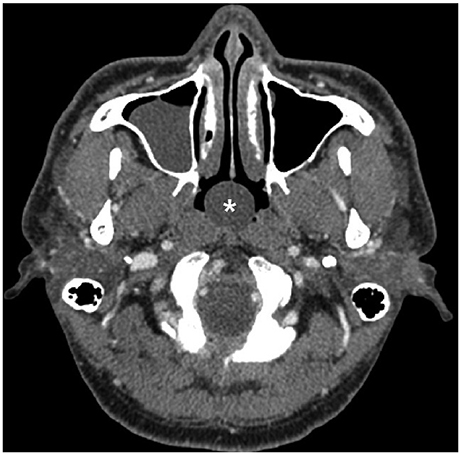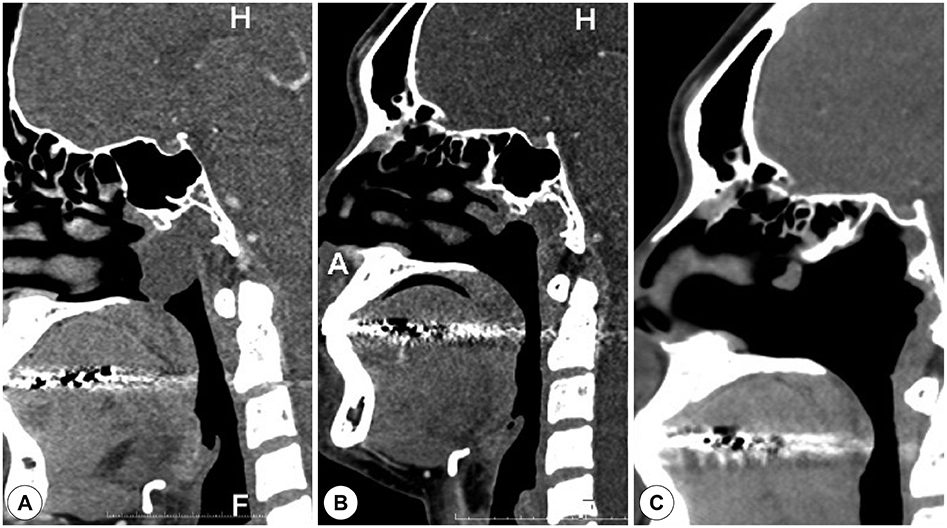J Rhinol.
2019 May;26(1):47-51. 10.18787/jr.2019.26.1.47.
Incidentally-Discovered Extraosseous Cystic Nasopharyngeal Chordoma in a Papillary Thyroid Cancer Patient
- Affiliations
-
- 1Department of Otorhinolaryngology-Head & Neck Surgery, College of Medicine, Korea University, Seoul, Korea. doctorth@korea.ac.kr
- KMID: 2449029
- DOI: http://doi.org/10.18787/jr.2019.26.1.47
Abstract
- Skull base chordomas are rare, malignant tumors arising from primitive notochord remnants of the axial skeleton and comprise approximately 25-35% of all chordoma cases. Nasal endoscopy in previous case reports has characterized nasopharyngeal chordomas as firm, semi-translucent masses protruding from the posterior nasopharyngeal wall with a pink, "meaty" appearance. However, the nasopharyngeal chordoma in the present case had a soft, cystic appearance, unlike the tumors previously described. Herein, an unusual case of an incidentally discovered nasopharyngeal chordoma is reported in a patient with papillary thyroid cancer; the discovered chordoma had a benign cystic appearance with no abnormal positron emission tomography-computed tomography (PET-CT) uptake.
Keyword
MeSH Terms
Figure
Reference
-
1. Kataria SP, Batra A, Singh G, Kumar S, Sen R. Chordoma of skull base presenting as nasopharyngeal mass. Journal of Neurosciences in Rural Practice. 2013; 4:Suppl 1. S95–S97.
Article2. Nishiguchi T, Mochizuki K, Ohsawa M, Inoue T, Kageyama K, Suzuki A, et al. Differentiating Benign Notochordal Cell Tumors From Chordomas: Radiographic Features on MRI, CT, and Tomography. American Journal of Roentgenology. 2011; 196(3):644–650.
Article3. Campbell WM, McDonald TJ, Unni KK, Laws ER, Jr . Nasal and paranasal presentations of chordomas. Laryngoscope. 1980; 90(4):612–618.
Article4. Alshammari J, Monnier P, Daniel RT, Sandu K. Clival chordoma with an atypical presentation: a case report. J Med Case Rep. 2012; 6:410.
Article5. Casals MM, Hunter SB, Olson JJ, Gussack G, Blevins LS Jr. Metastatic follicular thyroid carcinoma masquerading as a chordoma. Thyroid: official journal of the American Thyroid Association. 1995; 5(3):217–221.
Article6. Sivakumar S. Primary extranotochordal cervical chordoma masquerading as a thyroid neoplasm: a case report. Acta Cytologica. 2010; 54:5 Suppl. 823–828.7. Deconde AS, Sanaiha Y, Suh JD, Bhuta S, Bergsneider M, Wang MB. Metastatic disease to the clivus mimicking clival chordomas. Journal of Neurological Surgery. Part B, Skull Base. 2013; 74(5):292–299.
Article8. Santegoeds RGC, Temel Y, Beckervordersandforth JC, Van Overbeeke JJ, Hoeberigs CM. State-of-the-Art Imaging in Human Chordoma of the Skull Base. Current Radiology Reports. 2018; 6(5):16.
Article9. Flavell RR, Naeger DM, Mari Aparici C, Hawkins RA, Pampaloni MH, Behr SC. Malignancies with Low Fluorodeoxyglucose Uptake at PET/CT: Pitfalls and Prognostic Importance: Resident and Fellow Education Feature. Radiographics. 2016; 36(1):293–294.
Article10. Mitra B, Sengupta S, Rai A, Mehta J, Quader AR, Roy S, et al. Chordoma in Nasopharynx in a 70-Year-Old Female: A Rare Occurence. International Journal of Otolaryngology and Head & Neck Surgery. 2014; 3(3):342–346.
Article11. Fraser JF, Nyquist GG, Moore N, Anand VK, Schwartz TH. Endoscopic endonasal transclival resection of chordomas: operative technique, clinical outcome, and review of the literature. Journal of Neurosurgery. 2010; 112(5):1061–1069.
Article
- Full Text Links
- Actions
-
Cited
- CITED
-
- Close
- Share
- Similar articles
-
- A Case of Cystic Lymph Node Metastasis from Thyroid Papillary Microcarcinoma
- Thyroid Hemiagenesis Associated with Micropapillary Thyroid Carcinoma
- A Case of Ectopic Thyroid Papillary Carcinoma with Incidental Papillary Thyroid Microcarcinoma
- Development of Graves' Ophthalmopathy after Radioactive Iodine Ablation Using Recombinant Human Thyrotropin for Incidentally Discovered Papillary Thyroid Carcinoma
- Primary Nasopharyngeal Chordoma: A Case Report






